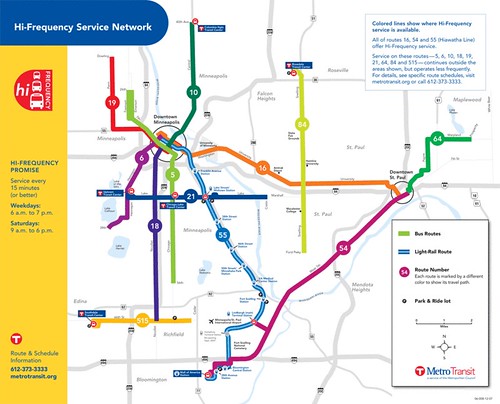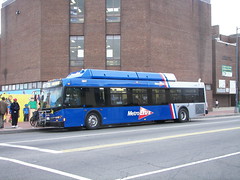Montgomery County Action Committee for Transit June meeting and Bus Rapid Transit vs. High Frequency Transit

From email:
Please join Action Committee for Transit on Tuesday, June 8th at 7:30pm. Program: A plan for a countywide "bus rapid transit" network. Speaker: Montgomery County Councilmember Marc Elrich. The meeting is at Silver Spring Center, 8818 Georgia Ave which is a ten minute walk north from the Silver Spring Metro. Metrobus "Q" and "Y" routes stop in front of the Center. Ride On #5 stops two blocks west of the Center.
--
News update: Metro has adopted a budget with no service cuts, and the county budget has minimal service cuts for Ride-On. Thanks to all the ACT members and others who worked to make that possible!
No Ride-On routes will be eliminated or have reduced hours of service. A few routes have low-ridership segments eliminated. Many will have slightly longer waits between buses. For more details go to http://www.actfortransit.org/bus.html
------
Marc Elrich has been pushing bus rapid transit in Montgomery County for a couple years (see five posts on the Elrich Plan from the Maryland Politics Watch blog, "Part One," "Part Two," "Part Three," "Part Four," and "Part Five.")
Myself, I am not a big fan of bus rapid transit, but if done properly it can be an important component of a regional transportation program.
See, bus rapid transit has mostly been sold as a bill of goods. It had been promoted by the Federal Transit Administration because it is cheaper than fixed rail transit. But for the most part, in North America there hasn't been the experience of high usage except in very dense areas, mostly Los Angeles.
It's a much different experience compared to South America, where fewer people own cars, and wages are low, so bus fares can be low, and where people are willing to withstand passenger density at rates almost 2x that of people in the U.S. So it means to carry the same number of people on a 60 foot articulated bus in Bogota, in the U.S. you need two buses and two bus drivers. That costs more...
See "bus rapid transit: some questions to ask," from the Human Transit blog. The questions:
1. Are we talking about exclusive right of way?
2. Is it a fully separated busway?
3. Are there exceptions to the stated degree of exclusivity and separation? If so, where, and why?
4. Is it [an] "open" or "closed" [bus system with main branches and secondary branches]? plus
- What is the overall level of design and amenity?
- How much money have we saved against the rail option, and how much more service will that buy
I think the real question is the necessity of creating a set of high frequency transit corridors. In "sydney: grid networks for gridless cities" Human Transit defines the "frequent network" as:
the portion of the network where you don't have to worry about a timetable, and where transit can therefore be used with some sense of spontaneity and freedom.
(This is why people like Circulator buses in DC. My problem with the Circulator buses is that many of the lines, developed for political reasons, provide frequent services in areas where there isn't demand for such service, and that we need to define the overall transit network in terms of primary and high frequency services, secondary services, and neighborhood-based services focused on intra-neighborhood transit and delivery of riders to the primary services.)
The City of Boulder Transit System Plan makes a similar point, in part of their definition of what they call the five characteristics for successful transit:
- Route structure: Does the service take you from where you begin your trip to your destination?
- Hours of service: Is the service available when you want to take your trip?
- Frequency: Is the service
convenient so you do not have a long wait for the bus? - Vehicles: Are the vehicles inviting and user friendly? and;
- Pass programs: Does the fare system encourage the efficient use of transit while generating sufficient revenue?

High frequency bus network map, Minneapolis.

WMATA has been introducing more limited stop services (MetroExtra) to speed travel along long bus corridors, but these aren't BRT services, they are what I call "rapider" transit.
I don't know how well the services work on Georgia Avenue and 16th Street NW in DC only because I've never had occasion to compare the services. (The MetroExtra stop "near" my house is a few blocks away from the regular stop, plus for the most part, I can ride my bike faster up or down Georgia Avenue than even the rapid buses, at least during rush periods.)
In Baltimore, I have ridden the buses on York Road quite a bit (until I got a "Baltimore" bike for my Penn Station to Towson trek), from North Avenue to Towson and back. The 8 is the local service bus making myriad stops. The 48 is a limited stop service. I've made it up to Towson (about 7 miles away) in as little as 20 minutes on the 48. Although at times the 8 can be quite fast as well (or very slow). The 8 provides as many as 6 buses/hour and is a backbone service.
By directing major bus service to corridors, you can provide more frequent service. And by setting up limited stop bus service within the overall service profile, you can serve two very different types of riders, those looking to cover long distances relatively quickly, and those people traveling shorter distances (or transferring from other routes to reach their final destination).
A complete transit service framework should be a combination of local and limited stop service options, at least during peak periods.
And it should be the overall framework of the transit network that we consider, rather than get hung up on the type of service (local bus, rapid bus, streetcar, light rail, heavy rail, railroad) that is used in order to provide the specific type of service in a particular place in the transit shed (see "Updating the mobilityshed concept").
Labels: bus rapid transit, transit infrastructure, transit marketing, transportation planning



0 Comments:
Post a Comment
<< Home